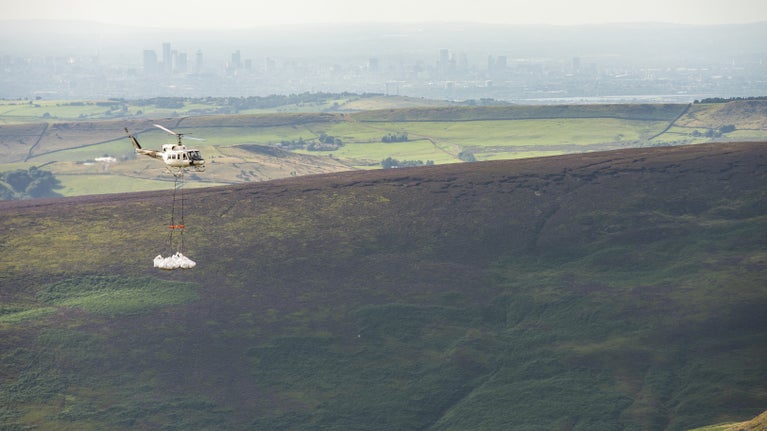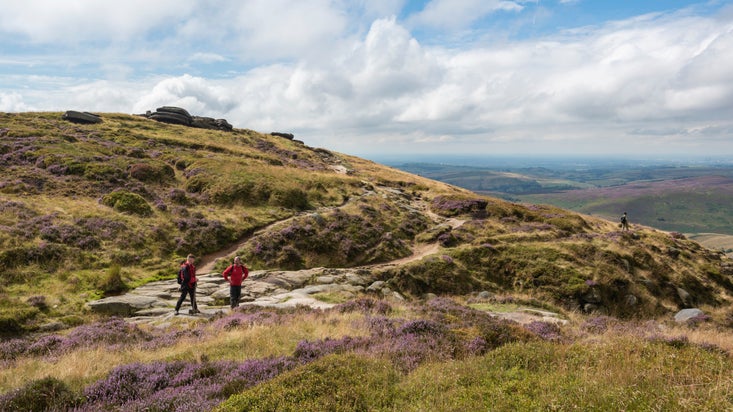Kinder Scout peatland restoration works resume with a dramatic start
- Published:
- 19 August 2024
- Last updated:
- 19 August 2024

Work to restore peatland on one of the most iconic parts of the Peak District is off to a dramatic start with helicopters delivering materials to remote locations on Kinder Scout for the next chapter in the National Trust’s peatland restoration work .
The importance of peatland restoration
The work will help to restore another 526 hectares of peatland on Kinder Scout to capture carbon as well as slowing the flow of water off the moor to reduce the risk of flooding and improve water quality. At the same time, it will provide vital homes for wildlife and make the landscape more resilient to climate change.
Phil Owen, project manager for peatland restoration at the National Trust in the Peak District explained why the project is so important and the role the helicopters play: “It is exciting to see the next phase of this large-scale peatland restoration start again. In good condition the moorlands of the Peak District can help reduce the impact of climate change by locking away carbon and slowing the flow of rainwater further downstream, so it’s vital that we do as much restoration as quickly as we can.
“The helicopters are transporting the materials needed to start the restoration process by stabilising bare peat and creating the right conditions for a variety of moorland plants to grow. Without helicopters, we wouldn't be able to work in such remote and sensitive areas where the only other access is by foot."

Getting materials to remote locations
The first helicopter lifts carried heather brash, lime, seed and fertiliser to some of the hardest to reach locations on this iconic Peak District landmark, which will be used to stabilise bare peat by temporarily lowering its acidity and create the right conditions for moorland plants to grow.
Other vital components of the project to help peat bogs form and hold water on the moors include building thousands of stone dams in gullies and planting hundreds of thousands of small sphagnum moss plugs.
The work so far
Earlier this year, in the first phase of the project, around 130,000 of the 800,000 sphagnum moss plug plants needed for the restoration were planted before work paused for ground nesting bird season. Once the newly planted sphagnum moss plugs have established, they will act as 'speed-bumps' for rainwater falling on the moors, forcing it to weave its way slowly down the moorland slopes instead of running in a straight line. This helps to create healthier blanket bog, protect the area’s precious peat and slow the flow of rainwater across the landscape and alleviate flooding.
More benefits of healthy peatlands
The restoration work will create sufficiently wet conditions for a mix of moorland plants like heather, bilberry, and cotton grass to grow, which will help to protect the landscape for future generations at the same time as creating homes for wildlife like dragonflies, golden plover, frogs and lizards.
Over time, the work will also help create the right conditions for peat to actively form, allowing the site to better lock up carbon and provide unique habitats for wildlife.
Maintaining access for people
The later stage of the project will also see the restoration of many of the National Nature Reserve’s footpaths, working to reduce erosion as well as ensuring people can continue to enjoy Kinder Scout at its best and immerse themselves in its rich history as the site of the historic mass trespass events which led to the formation of the National Parks in the early twentieth century.
How is the project funded?
The restoration of the Peak District’s peatlands has been made possible thanks to part of a grand total of £1.86m of funding from Natural England’s Nature for Climate Peatland Grant Scheme (NCPGS) as well as £400,000 the National Trust have allocated to carry out the restoration works on Kinder Scout.
Steve Clarke, Scheme Manager for Nature for Climate Peatland Grant Scheme at Natural England said: “The projects in the Scheme are set to make a significant reduction in the amount of carbon being lost from England’s degrading peat beds, as well as producing a host of other benefits for landscape, water and biodiversity.”
This work continues decades of collaboration to restore the Peak District’s precious peatlands including working with organisations who are part of the Moors for the Future Partnership. Building on these long-standing partnerships, the works are also supported by a further £200,000 from United Utilities.
Peatland restoration commitment
This project on Kinder Scout is expected to be completed by 2025 and will help the National Trust to move closer to achieving its commitment to have all the degraded peatlands in their care under restoration by 2040.
Find out more about our work with peatlands

Preserving our peatland
Discover the vital ways peat supports the environment, from carbon store to archaeological record, and see some of our key projects protecting and restoring the peatland in our care.